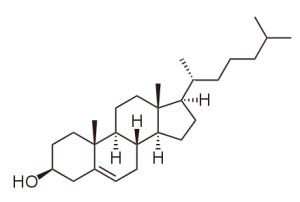Is Fossil-Associated Cholesterol a Biomarker for a Young Earth?
Like many Americans, I receive a yearly physical. Even though I find these exams to be a bit of a nuisance, I recognize their importance. These annual checkups allow my doctor to get a read on my overall health.
An important part of any physical exam is blood work. Screening a patient’s blood for specific biomarkers gives physicians data that allows them to assess a patient’s risk for various diseases. For example, the blood levels of total cholesterol and the ratio of HDLs to LDLs serve as useful biomarkers for cardiovascular disease.
Figure 1: Cholesterol. Image credit: BorisTM. Public domain via Wikimedia Commons, https://commons.wikimedia.org/wiki/File:Cholesterol.svg.
As it turns out, physicians aren’t the only ones who use cholesterol as a diagnostic biomarker. So, too, do paleontologists. In fact, recently a team of paleontologists used cholesterol biomarkers to determine the identity of an enigmatic fossil recovered in Precambrian rock formations that dated to 588 million years in age.1 This diagnosis was possible because they were able to extract low levels of cholesterol derivatives from the fossil. Based on the chemical profile of the extracts, researchers concluded that Dickinsonia specimens are the fossil remains of some of the oldest animals on Earth.
Without question, this finding has important implications for how we understand the origin and history of animal life on Earth. But young-earth creationists (YECs) think that this finding has important implications for another reason. They believe that the recovery of cholesterol derivatives from Dickinsonia provides compelling evidence that the earth is only a few thousand years old and the fossil record results from a worldwide flood event. They argue that there is no way organic materials such as cholesterol could survive for hundreds of millions of years in the geological column. Consequently, they argue that the methods used to date fossils such as Dickinsonia must not be reliable, calling into question the age of the earth determined by radiometric techniques.
Is this claim valid? Is the recovery of cholesterol derivatives from fossils that date to hundreds of millions of years evidence for a young earth? Or can the recovery of cholesterol derivatives from 588 million-year-old fossils be explained in an old-earth paradigm?
How Can Cholesterol Derivatives Survive for Millions of Years?
Despite the protests of YECs, for several converging reasons the isolation of cholesterol derivatives from the Dickinsonia specimen is easily explained—even if the specimen dates to 588 million years in age.
- The research team did not recover high levels of cholesterol from the Dickinsonia specimen (which would be expected if the fossils were only 3,000 years old), but trace levels of cholestane (which would be expected if the fossils were hundreds of millions of years old). Cholestane is a chemical derivative of cholesterol that is produced when cholesterol undergoes diagenetic changes.
Figure 2: Cholestane. Image credit: Calvero. (Self-made with ChemDraw.) Public domain via Wikimedia Commons, https://commons.wikimedia.org/wiki/File:Cholestane.svg.
- Cholestane is a chemically inert hydrocarbon that is expected to be stable for vast periods of time. In fact, geochemists have recovered steranes (other biomarkers) from rock formations that date to 2.8 billion years in age.
- The Dickinsonia specimens that yielded cholestanes were exceptionally well-preserved. Specifically, they were unearthed from the White Sea Cliffs in northwest Russia. This rock formation has escaped deep burial and geological heating, making it all the more reasonable that compounds such as cholestanes could survive for nearly 600 million years.
In short, the recovery of cholesterol derivatives from Dickinsonia does not reflect poorly on the health of the old-earth paradigm. When the chemical properties of cholesterol and cholestane are considered, and given the preservation conditions of the Dickinsonia specimens, the interpretation that these materials were recovered from 588-million-year-old fossil specimens passes the physical exam.
Resources
- Dinosaur Blood and the Age of the Earth by Fazale Rana (book)
- “What Dinosaur Soft Tissue Says about the Earth’s Age” by Fazale Rana (article)
- “Does Dinosaur Tissue Challenge Evolutionary Timescales? A Response to Kevin Anderson, Part 1” by Fazale Rana (article)
- “Does Dinosaur Tissue Challenge Evolutionary Timescales? A Response to Kevin Anderson, Part 2” by Fazale Rana (article)
- “Does the Recovery of Oils from a Fossilized Bird Evince a Young Earth?” by Fazale Rana (article)
- “Can Keratin in Feathers Survive for Millions of Years?” by Fazale Rana (article)
- “Science News Flash: An Old-Earth Perspective on Dinosaur Feathers Preserved in Amber” by Fazale Rana (article)
- “Does Radiocarbon Dating Prove a Young Earth: A Response to Vernon R. Cupps” by Fazale Rana (article)
Featured image: Dickinsonia Costata. Image credit: https://commons.wikimedia.org/wiki/File:DickinsoniaCostata.jpg.
Endnotes
- Ilya Bobrovskiy et al., “Ancient Steroids Establish the Ediacaran Fossil Dickinsonia as One of the Earliest Animals,” Science 361 (September 21, 2018): 1246–49, doi:10.1126/science.aat7228.








